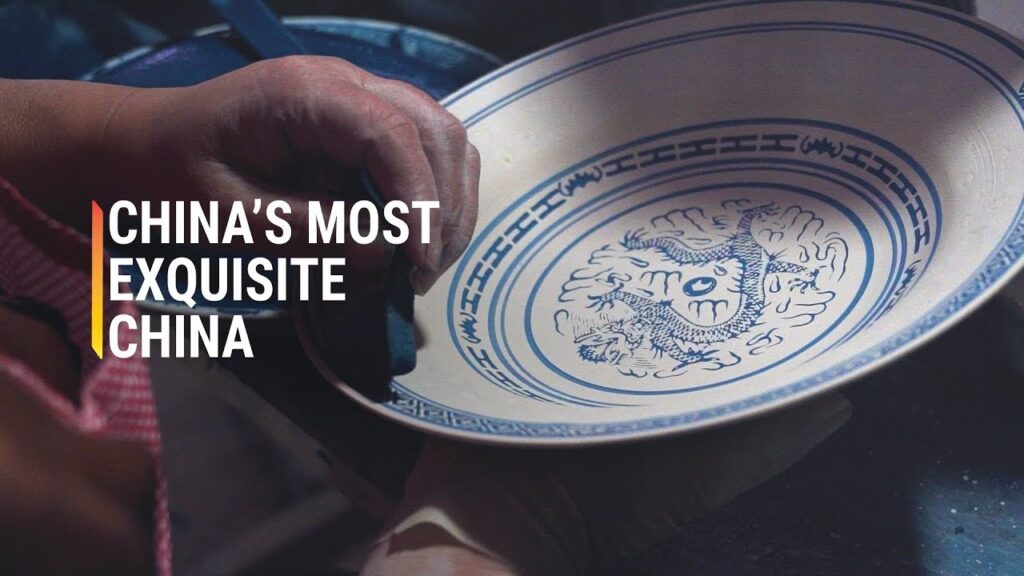These bowls, called linglong (玲珑) porcelain, used to be everywhere in the West. And they all come from this one town in China.
We visited one of the last factories that still makes this style of blue and white porcelain, and deciphered the symbols that cover the bowl.
Follow us on Instagram for behind-the-scenes moments:
Stay updated on Twitter:
Join the conversation on Facebook:
Have story ideas? Send them to us at hello@goldthread2.com
Written and Voiceover by: Clarissa Wei
Produced and Shot by: Nathaniel Brown and Clarissa Wei
Edited by: Nicholas Ko
Animated by: Ray Ngan
Special Thanks: Dolly Li, Nicholas Ko, Hanley Chu
Mastered by: Victor Peña
Music: Audio Network
#porcelain #artisan #artsandcrafts


I guess I should starting buying a bunch of these before theyre gone 😭
Yes, that’s what I am thinking too. I have many of the big soup bowls only. Will buy rice bowl too next day.
dont listen to the video. buy the lonquan celadon.
They will be around for hundreds of years before they are gone. Every family in Hong Kong and China has like 20 of them.
Stash them away for 50 years, then your grand kids can sell them for $10K as antiques.
I doubt that they will ever disappear from production, it can easily be brought back. The problem with collecting these is that there are no stamps to identify their age or time period. They all say ‘Made in China’, and i’m sure the ones produced 10 years from now will say the same thing.
Oh damn, seen these bowls so much but I didn’t even know the backstory behind em
Amazing video, my grandma always uses this bowl but never knew the story behind it! Hope it doesn’t get lost in history!
It will and hope he lives to 100 years old to run this factory.
Nah your grandma is mostly not these hand made one mostly the mechanized one
I remember these from when I was little. It’s so sad that they might not have it anymore in the future.
Wow, $0.30 per bowl? Even at wholesale that seems awfully low for the kind of labor and skills involved to make one.
@Ms. Chuisin sometimes Asian supermarkets sell them
They were sold for $1 in San Francisco in 90s. I don’t see them around anymore.
What about the ingredients’ cost and workers salary? It’s not like they get them for free
Capitalism is beautiful. It makes even luxury items affordable to the lower class
@SupLeon no
This is so interesting and amazing. I wish can learn the traditional way to make them.
*oh okay I see. a good amount of time &effort is put into making these bowls. kudos.*
Never let ur own traditions fade regardless of where ever you are born !
My hometown is just a 3 hour drive from his town. I had a friend who went to the town to learn how to make porcelain
Woooowww this is amazing! We’ve got these at home but it never occurred to me to research about them. All I remember was my mum saying we had to be very careful when using so we didn’t break them. That they were precious. The old ones, not the new ones. The new ones are all “fake” she’d say 😂
Fascinating. I have this pattern of dishes and now know the background. Thanks. Please film the origins with the pattern that has 4 chinese characters in a circle that comes in 4 different colors, gaudy, but very Chinese
Yes! I remember learning about this in my history class in Taiwan.
I can’t believe it was made by skillful hand made stamp! I bought it in Australian chinese oriental market for $5 a bowl few years ago and still using it today
I have a set of these bowls passed down from grandma that are totally translucent. Obviously they’re for display only. Now I know the history behind it.
That sounds amazing, that they’re translucent.
@Goldthread the bowls are paper thin and they’re like 20% smaller than normal bowls so not for real use.
I have these bowls and rose family to.
Amazing peaces of ART.
my family had a bunch of these bowls when i was little. we still might have a few but hard to find them where i live now.
Thank you for making this program. I love these bowls and Liu Zongkuan is right: they aren’t making them like they used to. Recent bowls look like they are stencilled or sprayed with the designs instead of being stamped. The blues are more intense, but there is less variation and the pieces look less dynamic. I’m not rich and I eat from these every day. When they stop making them entirely, I won’t be able to afford “antique” LingLong porcelain. I’ve always loved the bats and the little cabbage leaves on the outside of the base.
Cool!!! Don’t lose this tradition of bowl making.
I bought a bunch of these bowls years ago in Seattle’s I district and will now treasure them more.
I hope to be able to learn this! I love this type of practical art!